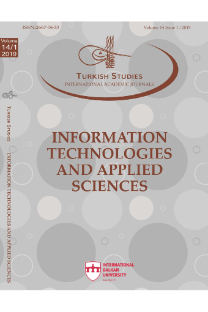CHILD CENTEREDNESS ON THE PUBLIC SECTOR WEBSITES
The spread of mobile technologies has changed the understandingthat condemns the internet to computers and place. Internet access andstaying connected are no longer a luxury consumption, but one of thebasic needs of social life. In the era that the use of the internet verywidened, websites which are one of the important corporatecommunication tools of brands, take a critical role. Public institutionspresent their services and works to the public through their websites.Children are an important target group for the services provided by thestate. Public institutions are obliged to express themselves not only toadults but also to children. For this purpose, some public institutionsinclude special contents for children on their websites. Websitespublished by the public sector for children directly serve this purpose.Internet usage patterns and behaviors of children are different thanadults. In this regard, children websites developed by public institutionsmust include certain usability and child-centered features. Childrenwebsites of public institutions are evaluated according to usability andchild-centeredness criteria within the scope of this work. The mainlegislative, executive and judicial institutions of the Republic of Turkeyand 100 official websites belonging to these institutions are involved inthis research by determining sitemaps, and 9 children websites wereanalyzed by the content analysis method. The results of the studyrevealed in detail the status of the child-centered websites of publicinstitutions in terms of evaluation criteria.
KAMU KURUMLARINA AİT İNTERNET SİTELERİNDE ÇOCUK ODAKLILIK
Mobil teknolojilerin yaygınlaşması, internet kullanımını bilgisayara ve mekana mahkum eden anlayışı değiştirmiştir. İnternet erişimi ve bağlantılı kalma durumu artık lüks bir tüketim olmaktan çıkmış, sosyal hayatın temel ihtiyaçlarından biri haline dönüşmüştür. İnternet kullanımının son derece yaygınlaştığı bir çağda, markaların önemli kurumsal iletişim kanallarından biri olan internet siteleri stratejik bir rol üstlenmektedir. Kamu kurumları sundukları hizmet ve çalışmaları internet siteleri aracılığıyla kamuoyuna aktarmaktadır. Çocuklar, devlet tarafından sunulan hizmetlerde önemli bir hedef kitledir. Kamu kurumları kendilerini sadece yetişkinlere değil aynı zamanda çocuklara da doğru anlatmak durumundadır. Bu amaçla çeşitli kamu kurumları internet sitelerinde çocuklara özel içerikler yayınlanmaktadır. Kamu kurumları tarafından yayınlanan çocuk internet siteleri ise doğrudan bu amaca hizmet etmektedir. Çocukların internet kullanım ve davranışları yetişkinlerden farklıdır. Bu bağlamda, kamu kurumları tarafından oluşturan çocuk internet sitelerinin birtakım kullanılabilirlik ve çocuk odaklılık özelliklerine sahip olması gerekmektedir. Çalışma kapsamında kamu kurumlarına ait çocuk internet siteleri kullanılabilirlik ve çocuk odaklılık kriterleri açısından değerlendirilmektedir. Türkiye Cumhuriyeti temel yasama, yürütme ve yargı kurumları ve bu kurumlara bağlı kuruluşlara ait 100 resmi internet sitesi, site haritaları çıkarılarak araştırmaya dahil edilmiş, aktif olarak yayın yapan 9 çocuk internet sitesi içerik analizi yöntemiyle incelenmiştir. Araştırma sonuçları kamu kurumlarına ait çocuk odaklı internet sitelerinin durumunu değerlendirme kriterleri açısından ayrıntılı bir şekilde ortaya koymaktadır.
___
Bayçu, S. (2012). Kurumsal Tasarım ve Görsel Kimlik. “Ed. Ferruh Öztuğ”, “Kurumsal İletişim”, 70-92. Anadolu Üniversitesi Yayınları.Blackwell, C. K., Lauricella, A. R., Conway, A., & Wartella, E. (2014). Children and the internet: Developmental implications of web site preferences among 8-to 12-year-old children. Journal of Broadcasting & Electronic Media, 58(1), 1-20.
Chand, B., Ramesha, B. (2017). DESIDOC Journal of Library & Information Technology, Vol. 37, No. 5, pp. 346-352,
Chhachhar, A. R., Qureshi, B., Maher, Z. A., & Ahmed, S. (2014). Influence of Internet Websites on Children Study. Journal of American Science, 10(5), 40-45.
Derome, J. (2015). Why First Impressions Matter. https://www.usertesting.com/blog/why-first-impressionsmatter Retrieved: 25.07.2019.
Durmuş, S., Çağıltay, K.(2012). Kamu Kurumu Web Siteleri ve Kullanılabilirlik. "E-Devlet Kamu Yönetimi ve Teknoloji İlişkisinde Güncel Gelişmeler", 293-322.
Esser, P. (2018). Implement Global Navigation to Improve Website Usability. https://www.interactiondesign.org/literature/article/implement-global-navigation-to-improve-website-usability Retrieved: 29.07.2019.
Google, (2019). Lighthouse Scoring Guide. https://developers.google.com/web/tools/lighthouse/v3/scoring Retrieved: 27.07.2019.
Gross, R. (2016). Designing websites for kids: Trends and best practices. https://www.canva.com/learn/kidswebsites Retrieved: 29.07.2019.
Idler, S. (2013). Contact Pages, Good vs Bad. https://usabilla.com/blog/good-vs-bad-contact-pages Retrieved: 19.07.2019.
KAMİS, (2019). KAMİS Rehberi v.2. https://kamis.gov.tr Retrieved: 16.07.2019.
Layne, K., Lee, J. (2001). Developing fully functional E-government: A four stage model. Government Information Quarterly, 18, 122.
Livingstone, S., & Bober, M. (2005). UK children go online: Final report of key project findings.
Mazzarella, S. R. (Ed.). (2005). Girl wide web: Girls, the Internet, and the negotiation of identity (Vol. 11). Peter Lang.
Nielsen, J. (2001). Search: Visible and Simple. https://www.nngroup.com/articles/search-visible-andsimple Retrieved: 28.07.2019.
Rideout, V. J., & Hamel, E. (2006). The media family: Electronic media in the lives of infants, toddlers, preschoolers and their parents. Henry J. Kaiser Family Foundation.
Santo, C. (1997). If it's out there, it's in here, as FamilyPC asks 1500 kids to rave about their faves. The Ultimate Guide to the Web: Far Out! Issue of FamilyPC. October
Schade, A. (2014). Responsive Web Design (RWD) and User Experience. https://www.nngroup.com/articles/responsive-web-design-definition Retrieved: 25.01.2019.
Sherwin, K., Nielsen, J. (2010). Children’s UX: Usability Issues in Designing for Young People. https://www.nngroup.com/articles/childrens-websites-usability-issues Retrieved: 27.07.2019.
TÜİK (2018). Hanehalkı Bilişim Teknolojileri Kullanım Araştırması. www.tuik.gov.tr Retrieved: 05.08.2019.
UNICEF. (2017). Children in a digital world. United Nations Children's Fund (UNICEF).
Wang, H.J., Lo, J. (2012). Determinants of citizens’ intent to use government websites in Taiwan. Information Development, 29 (2) 123–137.
- ISSN: 2667-5633
- Yayın Aralığı: Yılda 4 Sayı
- Başlangıç: 2006
- Yayıncı: ASOS Eğitim Bilişim Danışmanlık Otomasyon Yayıncılık Reklam Sanayi ve Ticaret LTD ŞTİ
Sayıdaki Diğer Makaleler
BURSA İLİ KIRSALINDA YAŞAYANLARIN BİLGİSAYAR OYUN ALIŞKANLIKLARI
İsmail Bülent GÜRBÜZ, Özgecan KADAĞAN
KAMU KURUMLARINA AİT İNTERNET SİTELERİNDE ÇOCUK ODAKLILIK
X, Y VE Z KUŞAKLARININ İNTERNETTEN ALIŞVERİŞ YAPMA EĞİLİMLERİNİ BELİRLEMEYE YÖNELİK BİR UYGULAMA
Necati Barkın AKAY, Gül Çoşkun DEĞİRMEN
EĞİTİM BİLİŞİM AĞI (EBA) DERS WEB SİTESİNE İLİŞKİN MATEMATİK ÖĞRETMENLERİNİN GÖRÜŞLERİ
MEHMET NURİ GÖMLEKSİZ, Hacer KOÇ DENİZ
TEKNOLOJİNİN OLANAKLARIYLA ÜRETİLEN DİJİTAL RESİM VE ÇİZİMDE DENEYSEL YAKLAŞIMLAR
7-9 YAŞ EĞİTİM HEDEFLİ YENİ MEDYA YAZILIMLARININ GÖRSEL TASARIMI VE ÖRNEK BİR İNCELEME: MORPA KAMPÜS
Dilek AYDEMİR, ATA YAKUP KAPTAN
CHILD CENTEREDNESS ON THE PUBLIC SECTOR WEBSITES
